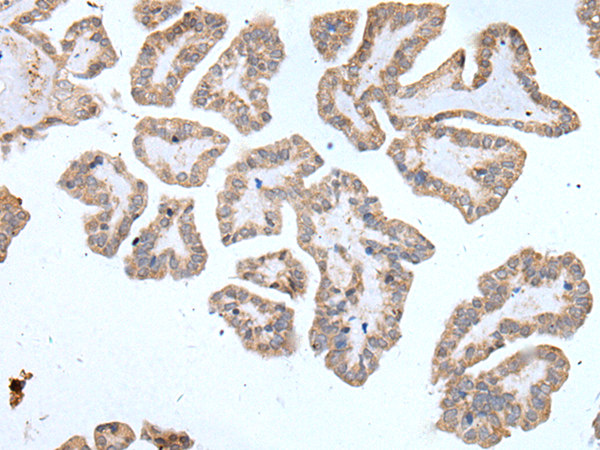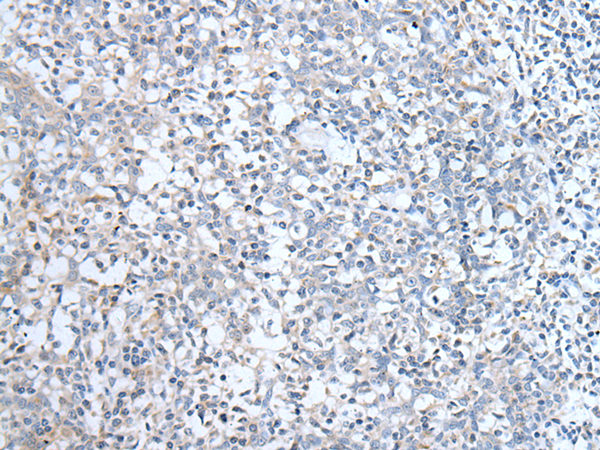

| WB | 1/2000 | Human,Mouse,Rat |
| IF | 咨询技术 | Human,Mouse,Rat |
| IHC | 咨询技术 | Human,Mouse,Rat |
| ICC | 技术咨询 | Human,Mouse,Rat |
| FCM | 1/25 | Human,Mouse,Rat |
| Elisa | 咨询技术 | Human,Mouse,Rat |
| Aliases | ALD; AMN; ALDP; ABC42 |
| Host/Isotype | Rabbit IgG |
| Antibody Type | Primary antibody |
| Storage | Store at 4°C short term. Aliquot and store at -20°C long term. Avoid freeze/thaw cycles. |
| Species Reactivity | Human, Mouse |
| Immunogen | Synthetic peptide of human ABCD1 |
| Formulation | Purified antibody in PBS with 0.05% sodium azide and 50% glycerol. |
+ +
以下是关于GARS抗体的3篇代表性文献的简要信息:
1. **《Clinical manifestations and outcomes of anti-glycyl tRNA synthetase antibody-positive patients》**
- 作者:Hirakata M, et al.
- 摘要:该研究分析了抗GARS抗体阳性患者的临床特征,发现其与间质性肺病(ILD)、关节炎和雷诺现象显著相关,提示该抗体可能是抗合成酶综合征的重要生物标志物。
2. **《The anti-synthetase syndrome: a review of the clinical spectrum and serological correlations》**
- 作者:Mammen AL.
- 摘要:综述了抗合成酶综合征(ASS)的临床表现,强调抗GARS抗体与其他抗氨酰-tRNA合成酶抗体(如抗Jo-1)的异同,指出GARS抗体患者更易出现皮肤病变和ILD。
3. **《Distinct clinical phenotypes of anti-glycyl tRNA synthetase antibodies in myositis》**
- 作者:Stone KB, et al.
- 摘要:通过多中心队列研究,发现携带抗GARS抗体的肌炎患者具有独特的临床表型,包括较低的肌肉受累频率,但更高的ILD发生率,支持其作为独立亚群的分类依据。
注:以上文献为示例性质,实际引用时建议通过PubMed或Google Scholar核对最新研究。如需具体发表年份或期刊信息,可进一步补充检索。
GARS antibodies target glycyl-tRNA synthetase (GARS), an enzyme critical for protein synthesis. As part of the aminoacyl-tRNA synthetase family, GARS catalyzes the attachment of glycine to its cognate tRNA during translation. Beyond its canonical role, GARS has garnered attention in autoimmune and neurological disorders. In autoimmune contexts, anti-GARS antibodies are biomarkers for antisynthetase syndrome (ASS), a condition characterized by myositis, interstitial lung disease, and arthritis. While anti-Jo-1 (targeting histidyl-tRNA synthetase) is the most common antisynthetase antibody, anti-GARS is rarer and linked to distinct clinical phenotypes, including prominent lung involvement. These autoantibodies may disrupt enzymatic function, triggering inflammation and tissue damage.
In neurology, dominant mutations in the *GARS* gene cause Charcot-Marie-Tooth disease type 2D (CMT2D), a peripheral neuropathy. Though distinct from autoimmune anti-GARS antibodies, research explores whether aberrant GARS function—whether from mutations or autoantibodies—shares pathways in neuronal or muscular dysfunction. Studies also investigate GARS’s non-canonical roles in signaling and inflammation, potentially bridging its involvement in diverse diseases. Clinically, detecting anti-GARS antibodies aids in diagnosing ASS subtypes, guiding treatment strategies like immunosuppression. Meanwhile, understanding GARS mutations or antibody interactions may reveal therapeutic targets for neurodegenerative or autoimmune conditions. Thus, GARS antibodies represent a nexus between fundamental biology, diagnostic tools, and disease mechanisms.
×